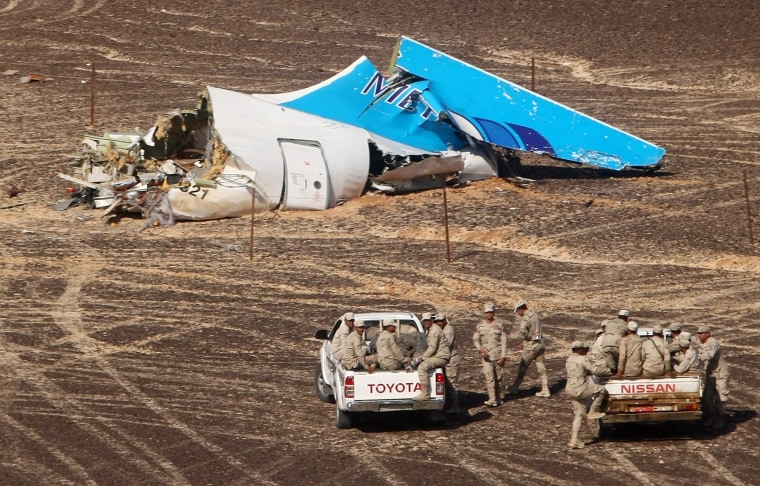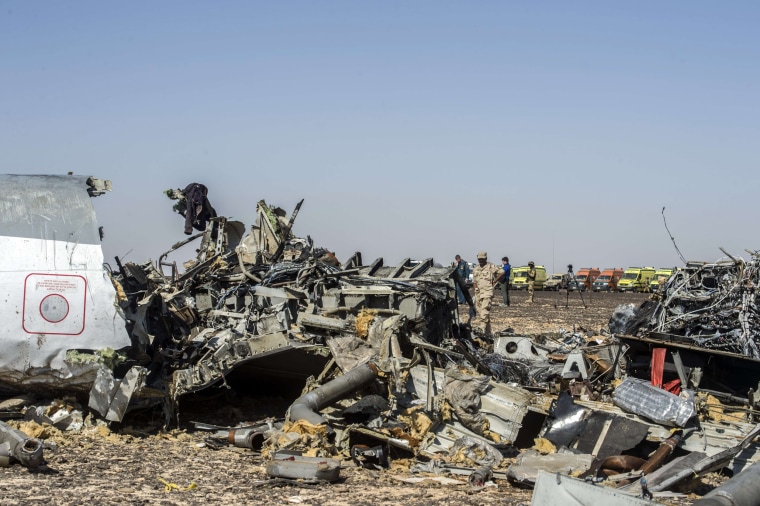As search teams combed a six square-mile area of Egyptian desert Monday for wreckage from the Metrojet plane crash, investigators were focusing on what might have caused the Airbus A321 to break up in midair.
Flight 7K9268 was carrying 224 passengers, mostly Russian vacationers, from the resort city of Sharm el-Sheikh to St. Petersburg early Saturday when it crashed over Sinai.
Alexander Neradko, head of Russia's federal aviation agency, told reporters Sunday that the large area over which plane debris fragments were found indicates the plane disintegrated in flight.
That view was echoed by aviation experts who told NBC News that images from the scene and the apparent lack of a distress call pointed to a catastrophic midair breakup — but there was already disagreement on whether mechanical failure, an explosion or something else was to blame.
“I think [they] are going to be able to tell I think what direction this investigation needs to go in pretty quickly, if they've got good information form the flight data recorder or the cockpit voice recorder,” said ex-NTSB investigator and NBC News air crash expert Greg Feith.
Mechanical or structural failure
A focus for investigators will be whether the 18-year-old plane was structurally compromised by a repair job after a 2001 accident in which its tail struck the runway during a landing at Cairo airport. The plane suffered “serious damage,” according to aviation publication Flight Global.
Post-accident repairs in the same section of the plane have caused at least two other midair breakups, including the world’s second-deadliest plane crash.
In 1985, Japan Airlines Flight 123 suffered an explosive decompression caused by a faulty repair carried out seven years earlier after a tail strike; the Boeing 747’s rear pressure bulkhead failed 12 minutes into the flight and it crashed into a mountainside, killing 505 of the 509 passengers on board. The rear pressure bulkhead is a sealed wall, between the back of the passenger cabin and the tail of the plane, which maintains the cabin pressure during flight.

“Tail strike damage tends to be around the region of the rear pressure bulkhead,” Tony Cable, a former senior investigator at the UK Air Accidents Investigation Branch, told The Guardian. “The cabin might be pressurized at around six pounds per square inch above outside pressure. But the fuselage directly behind that is at outside pressure. So any weakness or fatigue would be bad news.”
David Gleave, a U.K.-based aviation safety analyst, said: “The pictures from the Metrojet scene show the very rear of the aircraft, with what’s left of the tail fin, a considerable distance from the rest of the wreckage. That would suggest a clean break around the rear pressure bulkhead. I think investigators will be focusing very carefully on the repairs carried out.”
Alexander Smirnov, the deputy general director of Metrojet, told reporters in Russia Monday that a technical fault could not be to blame, and that the cause "could only have been a mechanical impact on the plane" in the air — but declined to elaborate. He insisted that the plane, registered in Ireland to a Dutch-owned leasing company, was fit to fly.
Gleave said tail strikes occur “about 10 times a year” and resulting damage could vary from nothing more than scraped paint to a structural problem. “There are probably about 250 aircraft flying around with these kinds of post-tail strike repairs,” he said. “As long as they have been carried out in line with manufacturers’ instructions there should be no problem.”
However, the co-pilot's wife told Russia's state-controlled NTV that her husband complained about the plane before taking off on the doomed flight.
"He complained before the flight that the technical condition of the aircraft left much to be desired," Natalya Trukhacheva said.
Explosion
“One of the things that you can’t rule out at this time is whether or not there was some sort of explosive device on board the aircraft,” said Feith.
Standards of security at Sharm el-Sheikh airport — a key driver of Egypt’s tourism economy — are relatively high and monitored by the dozens of European airlines that fly there. However, one theory is that explosives may have been smuggled aboard and detonated midair in a scenario similar to the inflight breakup of Pan Am Flight 103 over Lockerbie in 1988.
“It could have been a bomb,” Paul Rogers, a global security consultant and professor at the University of Bradford in England, told the BBC. “The fact is that Russia recently intervened in Syria and … this could be a nasty blowback as far as [President Vladimir] Putin is concerned. The reality is that neither Egypt nor Russia will want to admit it involved terrorism and it may never come out fully.”
Feith said analysis of the flight data recorder should quickly determine whether an explosion or a mechanical failure precipitated the break-up.
Photos: Investigators Search Crash Site of Russian Plane
“If it was an explosive device the flight data recorder won't exactly give you a lot of detail other than a lot of the parameters will go basically to their extremes,” he said. “You'll see a lot of things that won't look logical. The cockpit voice recorder if it has good data is probably the best source because it will record the instantaneous explosion or some sort of other telltale noise that investigators may be able to, through sound spectrum analysis, determine was an explosion on the aircraft of some source.”

Not every airplane explosion is deliberate, however. TWA Flight 800 broke apart in midair in 1996 after a fuel tank explosion that weakened the plane’s structure.
“They’re going to be looking at the flight controls, they’ll be looking at the fuel system and then they’ll also be looking at maintenance issues that may have induced some sort of technical failure,” Feith said.
Missile
A local ISIS affiliate claimed it brought down the aircraft, which crashed in an area where Egyptian military and security forces have battled militants for years.
It is a popular theory among mourners Russia. "Everyone thinks it was ... these Islamic fundamentalists," Mikhail Kudryavtsev told The Associated Press at a cathedral in St. Petersburg where hundreds of worshippers lit candles, laid flowers and prayed for the victims.
However, Russian officials and experts have dismissed claim as not credible because militants lacked the weapons to do it.
“I think the claims by ISIS are a propaganda grab,” said former captain and NBC News aviation expert John Cox. “They don't have the weaponry necessary to reach an airplane at 31,000 feet. They can only go to ten, maybe, 12,000 feet and this airplane was very much higher than that. I don't put any real credibility in the claim by ISIS at this point.”
That was echoed by Feith, who said investigators would be focusing on “some sort of onboard device rather than a shoot down” if an explosion were found to be the cause.
“From just a general understanding missiles won't typically from the ground launch to 30,000 feet, there is no evidence to suggest that,” he said.
